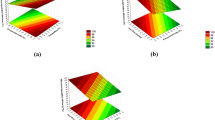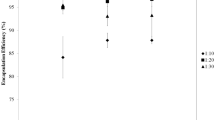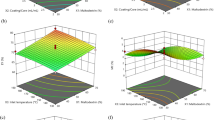Abstract
The objective of this study was to investigate storage and baking stability and in vitro digestibility of encapsulated phenolic powders obtained from micro- and nano-suspensions. In addition, it was aimed to study the influence of the incorporation of phenolic capsules into cakes on their quality and sensory attributes. Extraction of phenolic compounds from sour cherry pomace and concentration steps were used to obtain phenolic powders. Half of the concentrate was then freeze dried to produce extracted phenolic powder (EPP) and the rest was centrifuged at 10,000 rpm for 2 min before freeze drying to obtain purified extracted phenolic powder (PEPP). Phenolic powders were mixed with coating material containing 8 % maltodextrin and 2 % gum arabic at a core-to-coating ratio of 1:20 and homogenized by using ultrasound (160 W, 50 % pulse, 20 min). Micro-suspensions and nano-suspensions were prepared using EPP and PEPP, respectively. Suspensions were freeze dried to obtain capsules. Encapsulation had a positive effect on the hygroscopicity, in vitro digestibility and storage and baking stability of phenolic compounds. Loss of total phenolic content (TPC) of encapsulated EPP and PEPP was 10 % and 15 %, respectively, during storage at 43 % relative humidity (RH). Under the same conditions, uncoated EPP and PEPP lost TPC by 37 % and 43 %, respectively. There was no significant difference (p > 0.05) between encapsulated EPP and PEPP in terms of baking stability. Encapsulation was also effective in the masking of the flavor of the phenolic powders when capsules were incorporated into cakes. In addition, incorporation of capsules did not change quality parameters of cakes adversely.




Similar content being viewed by others
References
AACC. (1988). Approved methods of the AACC. Method 74-09. St. Paul: American Association of Cereal Chemist.
Bakowska-Barczak, A. M., & Kolodziejczyk, P. P. (2011). Black currant polyphenols: their storage stability and microencapsulation. Industrial Crops and Products, 34, 1301–1309.
Beretta, G., Granata, P., Ferrero, M., Orioli, M., & Maffei, F. R. (2005). Standardization of antioxidant properties of honey by a combination of spectrophotometric/fluorimetric assays and chemometrics. Analytica Chimica Acta, 533, 185–191.
Cai, Y. Z., & Corke, H. (2000). Production and properties of spray-dried Amaranthus Betacyanin Pigments. Journal of Food Science, 65, 1248–1252.
Hu, B., Pan, C., Sun, Y., Hou, Z., Ye, H., Hu, B., & Zeng, X. (2008). Optimization of fabrication parameters to produce chitosan–tripolyphosphate nanoparticles for delivery of tea catechins. Journal of Agricultural and Food Chemistry, 56, 7451–7458.
Kumari, A., Yadav, S. K., Pakade, Y. B., Kumar, V., Singh, B., Chaudhary, A., & Yadav, S. C. (2011). Nanoencapsulation and characterization of Albizia chinensis isolated antioxidant quercitrin on PLA nanoparticles. Colloids and Surfaces. B, Biointerfaces, 82, 224–232.
Laine, P., Kylli, P., Heinonen, M., & Jouppila, K. (2008). Storage stability of microencapsulated cloudberry (Rubus chamaemorus) phenolics. Journal of Agricultural and Food Chemistry, 56, 11251–11261.
Luca, A., Cilek, B., Hasirci, V., Sahin, S., & Sumnu, G. (2012). Effect of degritting of phenolic extract from sour cherry pomace on encapsulation efficiency-production of nano-suspension. Food Bioprocess Technology. doi:10.1007/s11947-012-0880-z.
Martinelli, L., Gabas, A. L., & Telis-Romero, J. (2007). Thermodynamic and quality properties of lemon juice powder as affected by maltodextrin and gum Arabic. Drying Technology, 25, 2035–2045.
Neethirajan, S., & Jayas, D. S. (2011). Nanotechnology for the food and bioprocessing industries. Food Bioprocess Technology, 4, 39–47.
Pharmacopeia (2000) National formulatory (USP 24 NF 19). Rockville, MD, US.
Pillai, D. S., Prabhasankar, P., Jena, B. S., & Anandharamakrishnan, C. (2012). Microencapsulation of garcinia cowa fruit extract and effect of its use on pasta process and quality. International Journal of Food Properties, 15, 590–604.
Saenz, C., Tapia, S., Chavez, J., & Robert, P. (2009). Microencapsulation by spray drying of bioactive compounds from cactus pear (Opuntia ficus-indica). Food Chemistry, 114, 616–622.
Sakiyan, O., Sumnu, G., Sahin, S., Meda, V., Koksel, H., & Chang, P. (2011). A study on degree of starch gelatinization in cakes baked in three different ovens. Food and Bioprocess Technology, 4, 1237–1244.
Sanchez, V., Baeza, R., Galmarini, M. V., Zamora, M. C., & Chirife, J. (2011). Freeze-drying encapsulation of red wine polyphenols in an amorphous matrix of maltodextrin. Food and Bioprocess Technology. doi:10.1007/s11947-011-0654-z.
Sansone, F., Picerno, P., Mencherini, T., Villecco, F., D’Ursi, A. M., Aquino, R. P., & Lauro, M. R. (2011). Flavonoid microparticles by spray-drying: influence of enhancers of the dissolution rate on properties and stability. Journal of Food Engineering, 103, 188–196.
Sessa, M., Casazza, A. A., Perego, P., Tsao, R., Ferrari, G., & Donsi, F. (2012). Exploitation of polyphenolic extracts from grape marc as natural antioxidants by encapsulation in lipid-based nanodelivery systems. Food and Bioprocess Technology. doi:10.1007/s11947-012-0911-9.
Silva, V. M., Kurozawa, L. E., Park, K. J., & Hubinger, M. D. (2012). Influence of carrier agents on the physicochemical properties of mussel protein hydrolysate powder. Drying Technology, 30, 653–663.
Spencer, J. P. E., Chowrimootoo, G., Choudhury, R., Debnam, E. S., Srai, S. K., & Rice-Evans, C. (1999). The small intestine can both absorb and glucuronidate luminal flavonoids. FEBS Letters, 458, 224–230.
Tonon, R. V., Brabet, C., Pallet, D., Brat, P., & Hubinger, M. D. (2009). Physicochemical and morphological characterisation of açai (Euterpe oleraceae Mart.) powder produced with different carrier agents. International Journal of Food Science and Technology, 44, 1950–1958.
Turabi, E., Sumnu, G., & Sahin, S. (2008). Optimization of baking of rice cakes in infrared-microwave combination oven by response surface methodology. Food and Bioprocess Technology, 1, 64–73.
Waterhouse, A. L. (2002). Determination of total phenolics. In R. E. Wrolstad (Ed.), Current protocols in food analytical chemistry (pp. 457–537). New York: Wiley.
Yen, G. C., & Duh, P. D. (1994). Scavenging effect of methanolic extracts of peanut hulls on free-radical and active oxygen species. Journal of Agricultural and Food Chemistry, 42, 629–932.
Zheng, C., Liu, Y., Zhou, Q., & Di, X. (2010). Capillary electrophoresis with noncovalently bilayer-coated capillaries for stability study of allergenic proteins in simulated gastrointestinal fluids. Journal of Chromatography B, 878, 2933–2936.
Zheng, L., Ding, Z., Zhang, M., & Sun, J. (2011). Microencapsulation of bayberry polyphenols by ethyl cellulose: preparation and characterization. Journal of Food Engineering, 104, 89–95.
Acknowledgment
The authors thank the Scientific and Technological Research Council of Turkey (TUBITAK 110O071 project number) for financial support.
Author information
Authors and Affiliations
Corresponding author
Rights and permissions
About this article
Cite this article
Luca, A., Cilek, B., Hasirci, V. et al. Storage and Baking Stability of Encapsulated Sour Cherry Phenolic Compounds Prepared from Micro- and Nano-Suspensions. Food Bioprocess Technol 7, 204–211 (2014). https://doi.org/10.1007/s11947-013-1048-1
Received:
Accepted:
Published:
Issue Date:
DOI: https://doi.org/10.1007/s11947-013-1048-1




